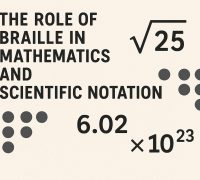The Importance of Braille in Mathematics and Science
Braille serves a pivotal function in enabling persons who are blind or visually impaired to gain access to mathematics and scientific notation. This tactile writing system offers them the capability to read and write by touch, thereby opening up equal opportunities to engage with STEM (Science, Technology, Engineering, and Mathematics) fields. When we delve into the ways Braille manages to navigate the complex world of mathematical and scientific notation, we can better appreciate its irreplaceable contributions to educational and professional settings.
Challenges in Mathematical and Scientific Braille
Mathematical and scientific Braille exhibit far more complexity than their literary counterpart due to the necessity to represent a wide array of symbols, equations, and expressions commonly used across these disciplines. The main challenge is translating intricate details into a format that remains both straightforward and comprehensible. Consequently, Braille transcriptions of mathematical content need to present a systematic and clear approach to denote various mathematical expressions and scientific notations accurately.
Navigating Mathematical Braille Codes
Mathematical Braille involves codes such as the Nemeth Code, which is widely used in the United States, or the modified Unified English Braille (UEB) for math. These codes have been developed to capture the unique aspects of mathematical content, including fractions, superscripts, subscripts, and other critical notations. Such rules ensure the conveyance of mathematical information in a structured manner.
The Nemeth Code, for instance, employs specialized symbols and formats to succinctly convey operations and relationships, making even the most complex subjects such as calculus and algebra accessible. The flexibility inherent in these codes enables a broad adaptation across a wide range of mathematical concepts.
Scientific Notation and Braille
Scientific notations bring another layer of complexity due to the involvement of specialized symbols and representations, such as Greek letters, exponents, and chemical formulas. For Braille users, specialized notation systems are critical for accurately conveying this information. Notation systems like Chemical/Braille notation are utilized to transcribe challenging chemical equations and intricate molecular structures.
For effective comprehension and application in scientific endeavors, educators and transcribers need to ensure that students and professionals achieve fluency in these notation systems.
Technological Aids and Braille Literacy
While traditional Braille continues to be crucial, technological improvements have considerably expanded the accessibility of mathematical and scientific content for Braille users. Devices such as digital Braille displays and refreshable Braille devices have the ability to convert digital content into tactile output. This advancement offers real-time access to intricate information, enhancing the learning experience.
Resources like the Perkins Braille Math Tutor play a significant role in this regard, allowing learners to interact dynamically with mathematical concepts. In tandem with these resources, software and educational tools supporting Braille notation further bolster accessibility. These tools comprise accessible graphing calculators and screen readers explicitly designed for mathematical content, ensuring blind and visually impaired students can engage equitably in math and science education.
Conclusion
Braille’s function in mathematics and scientific notation is essential for fostering inclusivity and empowerment. By ensuring that complex symbols and concepts are accessible through meticulous codes and technological advancements, Braille ensures no barriers hinder blind and visually impaired individuals from pursuing careers in STEM fields. The continued development and adaptation of Braille systems are vital in sustaining equitable access, promoting opportunities for exploration, and driving achievement within these crucial disciplines.



